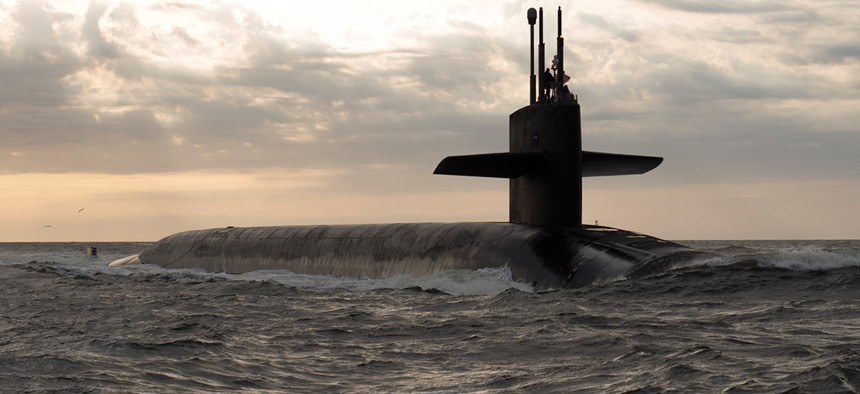
Ohio-class ballistic missile submarine USS Rhode Island (SSBN 740) returns to Naval Submarine Base Kings Bay, Georgia, Mar. 20, 2013. U.S. Navy photo by Mass Communication Specialist 1st Class James Kimber/Released
To Save the Submarines, Eliminate ICBMs and Bombers
If the Pentagon is serious about new Ohio-class SSBNs, then it should end the “nuclear triad” of missiles and bombers (freeing $20 billion a year). By Christopher Preble and Matt Fay
The Navy’s top admiral, Chief of Naval Operations Jonathan Greenert, recently called the replacement for the Ohio-class submarine, the SSBN(x), the service’s “top priority program.” But rather than prioritize funds for the program the Navy is asking Congress to pay for the nuclear submarines upgrade with bonus money.
They shouldn’t.
The Navy already is requesting $60 billion for the SSBN(x) as supplemental funding. At a recent hearing of the House Subcommittee on Seapower and Projection Forces, Rear Adm. Richard Breckenridge, the Navy’s director of undersea warfare, asked Congress for those funds and to exempt the SSBN(x) from the effects of sequestration. The plan to build twelve of the next-generation subs has quickly begun to eat away at the Navy’s overall shipbuilding budget, with recent projections placing its total cost between $93 and $100 billion.
Instead of skirting the rules to find funds for the program, the Pentagon should look elsewhere within the nuclear arsenal for the money it needs. Eliminating the other two legs of the nuclear triad -- intercontinental ballistic missiles, or ICBMs, and nuclear bombers -- would save American taxpayers around $20 billion a year. Part of the savings could be put toward replacing the Ohio-class subs.
The sea leg of the nuclear triad by itself is a more powerful deterrent than that possessed by nearly any other nation in the world. Russia retains a relatively large arsenal, but no other country is capable of deploying more than a few hundred nuclear warheads. A single Ohio-class submarine can carry up to 192.
The U.S. Navy currently deploys 14 SSBNs, each of which carries 24 Trident II D-5 submarine-launched ballistic missiles. Each Trident can carry up to six W88 warheads or eight W76 warheads, with respective yields of 475kt and 100kt. The D-5 missile has a range of approximately 7,000 miles, allowing it to strike nearly anywhere on the globe within 30 minutes, depending on its location when launched. It is believed to be as accurate as land-based ICBMs, and poses a clear and credible threat to any hardened target. Missiles in general are far superior as a delivery vehicle than bomber aircraft.
Given their stealth and survivability, SSBNs represent a secure second-strike force on their own. No other state now threatens America’s SSBN fleet. During the Cold War, some hawks claimed that SSBNs were vulnerable to Soviet antisubmarine warfare, or ASW, capabilities -- or would be in the near future. At the end of the Cold War, though, the General Accounting Office found that Soviet ASW capabilities were not only far behind what was assumed at the time, but also that U.S. submarines were likely to retain their technological edge. They have. Moreover, the type of breakthroughs that could threaten American submarines would have to be revolutionary in nature and therefore unlikely to be quickly deployable or remain unknown to U.S. intelligence. Washington would have ample lead-time to adjust and adapt. In the highly unlikely event an adversary developed advanced ASW capabilities, it would still need to have the confidence it could track and destroy the entire American SSBN fleet at sea to conduct a first strike or risk annihilation in return. After all, even a single surviving SSBN could unleash destruction never before seen in human history.
And yet, the Obama administration and other defenders of the status quo contend that all three delivery systems are necessary. Such claims do not bear scrutiny. For example, the administration’s 2010 Nuclear Posture Review argues that the triad must be maintained as a “technical hedge” -- in other words, don’t put all America’s nuclear eggs in one basket. This argument is unconvincing, particularly with respect to submarines. Even if the SSBN fleet shrinks from 14 to 12 with the shift to the SSBN(x), the proverbial eggs would remain in at least a dozen, well-hidden baskets. Moreover, SSBNs are well tested and the likelihood of technical failure is already low. For it to result in a deterrence failure, an adversary would have to know about the vulnerability in advance, be prepared to capitalize upon it and wager that the entire U.S. fleet was disabled.
Bombers and ICBMs, meanwhile, have significant flaws. Bombers are vulnerable both in the air and on the ground, and no more accurate than missiles. ICBMs, should they be used against rogues states like North Korea or Iran, would need to overfly either Russia or China (or both) -- forcing a choice of whether to give advance notification or risk the misperception of a hostile launch.
The reliance on three nuclear delivery systems is a relic of Cold War bureaucratic politics, not the product of strategic calculation. A submarine-based monad is more than sufficient for America’s deterrence needs, and would be considerably less expensive to modernize and maintain than the current force. The Navy would not have to skirt the law in a desperate bid to shake additional money from American taxpayers if the Obama administration shed its attachment to the nuclear triad.
Christopher Preble is vice president for defense and foreign policy studies at the Cato Institute. Matt Fay is a PhD student in the history department at Temple University.




